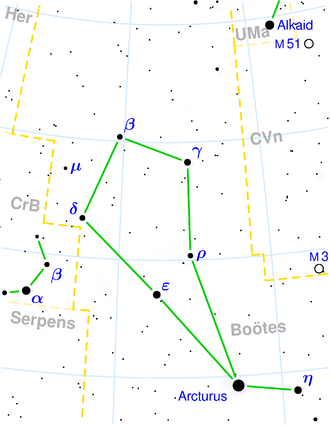NGC 5665
| Galaxy NGC 5665 |
|
|---|---|

|
|
| SDSS recording | |
| AladinLite | |
| Constellation | Bear keeper |
|
Position equinox : J2000.0 , epoch : J2000.0 |
|
| Right ascension | 14 h 32 m 25.7 s |
| declination | + 08 ° 04 ′ 43 ″ |
| Appearance | |
| Morphological type | SAB (rs) c pec? HII |
| Brightness (visual) | 12 likes |
| Brightness (B-band) | 12.7 mag |
| Angular expansion | 2.1 ′ × 1.3 ′ |
| Position angle | 145 ° |
| Surface brightness | 12.9 mag / arcmin² |
| Physical data | |
| Redshift | 0.007431 ± 0.000017 |
| Radial velocity | (2228 ± 5) km / s |
|
Stroke distance v rad / H 0 |
(100 ± 7) x 10 6 ly (30.6 ± 2.1) Mpc |
| diameter | 60,000 ly |
| history | |
| discovery | William Herschel |
| Discovery date | January 30, 1784 |
| Catalog names | |
| NGC 5665 • UGC 9352 • PGC 51953 • CGCG 047-084 • MCG + 01-37-024 • IRAS 14299 + 0817 • 2MASX J14322579 + 0804424 • Arp 49 • VV 412 • GC 3923 • H II 27 • h 1833 • | |
NGC 5665 is a bar-spiral galaxy of the Hubble type SAB (rs) c pec in the constellation Bear Keeper in the northern sky . It is about 100 million light years away from the Milky Way and has a diameter of about 60,000 light years . Halton Arp organized his catalog of unusual galaxies into groups according to purely morphological criteria. This galaxy belongs to the class spiral galaxies with a small companion of high surface brightness on one arm (Arp catalog) . The galaxy may have a small 2,000 light year diameter companion within its spiral arms that led to this cataloging. Or maybe it is just a particularly large star formation region , because NGC 5665 is also listed as a starburst galaxy .
The object was discovered on January 30, 1784 by William Herschel.
Web links
literature
- Jeff Kanipe and Dennis Webb: The Arp Atlas of Peculiar Galaxies - A Chronicle and Observer's Guide , Richmond 2006, ISBN 978-0-943396-76-7
